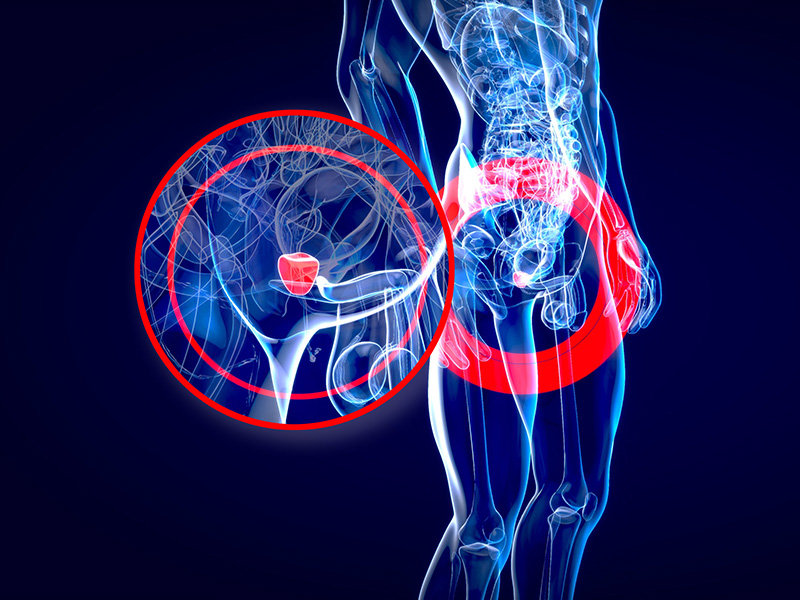
Prostate Enlargement Treatment in Dubai
The prostate is a small and round organ that is part of the male reproductive system. It is located below the bladder and surrounds the urethra, the tube that carries urine and semen out of the body. The main function of the prostate is to produce and secrete a fluid that makes up part of semen. The prostate is also important for maintaining the health and function of the male urinary and reproductive systems.
However, the prostate can also be prone to a variety of health problems, including prostate cancer, prostatitis (inflammation of the prostate), and benign prostatic hyperplasia (BPH), which is an enlargement of the prostate that can cause urinary symptoms. Quironsalud Urology Department dedicates highly experienced doctors to provide regular prostate exams and screenings that are important for detecting and managing these conditions.

Benign Prostatic Hyperplasia
Benign prostatic hyperplasia (BPH) is a non-cancerous enlargement of the prostate gland that commonly affects men as they age. As the prostate grows larger, it can squeeze and constrict the urethra. The signs and symptoms of benign prostatic hyperplasia (BPH) can vary in severity and may include:
- Urinary frequency: the need to urinate frequently, often more than eight times a day.
- Urgency: the sudden, strong urge to urinate, which may be difficult to control.
- Weak urine stream: a stream of urine that is weak, slow or interrupted.
- Straining to urinate: difficulty in starting urination or straining to push out urine.
- Incomplete bladder emptying: feeling like there is still urine in the bladder after urination.
- Nocturia: the need to urinate two or more times during the night.
- Urinary retention: the inability to completely empty the bladder.
- Urinary incontinence: leaking urine, particularly when laughing or coughing.
- Blood in the urine: this is not common, but may occur in some cases.
The exact cause of BPH is not well understood, but it is believed to be related to changes in hormone levels and growth factors in the prostate gland. BPH is typically diagnosed through a physical exam, including a digital rectal exam, and other tests such as a urine flow test or prostate-specific antigen (PSA) blood test.

Risk Factors
There are several risk factors that can increase a man’s chances of developing benign prostatic hyperplasia (BPH), including:
- Age: BPH is more common in men over the age of 50, and the risk increases with age.
- Family history: Men with a family history of BPH or prostate cancer may be at higher risk.
- Obesity: Being overweight or obese may increase the risk of BPH.
- Hormonal imbalances or changes in hormone levels
- Lifestyle factors: Certain lifestyle factors, such as lack of physical activity and a diet high in fat and red meat, may increase the risk of BPH.
- Medical conditions: Certain medical conditions, such as diabetes and heart disease, may increase the risk of BPH.
While these risk factors may increase a man’s chances of developing BPH, it is important to note that many men with no known risk factors can still develop the condition. Regular prostate exams and screenings are important for detecting and managing BPH, especially in men over the age of 50.
Diagnosis
The diagnosis of benign prostatic hyperplasia (BPH) involves a combination of medical history, physical exam, and diagnostic tests. The healthcare provider will typically ask about the patient’s symptoms and medical history, as well as perform a physical exam, which may include a digital rectal exam (DRE) to assess the size and shape of the prostate.
In addition, diagnostic tests may be ordered to help confirm the diagnosis and rule out other conditions. These tests may include:
- Urinalysis: to check for signs of infection or blood in the urine.
- to screen for prostate cancer.
- Uroflowmetry: a noninvasive test that measures the speed and volume of urine flow.
- Post-void residual (PVR) measurement: a test that uses ultrasound or catheterization to measure how much urine remains in the bladder after urination.
- Transrectal ultrasound (TRUS): a test that uses sound waves to create images of the prostate gland.
Based on the results of these tests, the healthcare provider may be able to diagnose BPH and determine the severity of the condition. The diagnosis will guide the treatment plan, which may include medications, lifestyle changes, or surgery.
Treatment
There are several treatment options for benign prostatic hyperplasia (BPH), depending on the severity of symptoms and the individual’s overall health. Treatment options may include:
- Medications: Several types of medications can be used to treat BPH which relax the muscles of the prostate and bladder, or shrink the prostate gland.
- Minimally invasive procedures
- Surgery: For more severe cases of BPH, surgery may be necessary to remove excess prostate tissue.
- Lifestyle changes: Certain lifestyle changes can help alleviate symptoms of BPH, such as reducing caffeine and alcohol intake, practicing pelvic floor exercises, and avoiding fluids before bedtime.
Treatment for BPH should be tailored to the individual’s specific needs and preferences, and may involve a combination of approaches.
Prostate Infection (Prostatitis)
Prostate infection, also known as prostatitis, is an inflammation of the prostate gland that can cause a variety of symptoms. Prostatitis can be caused by bacterial or non-bacterial infections, as well as certain medical procedures or other conditions. Symptoms of prostate infection may include:
- Pain or discomfort in the pelvic area or lower back
- Pain or burning during urination
- Frequent urination
- Urgency to urinate
- Difficulty starting or stopping urination
- Blood in the urine or semen
- Pain or discomfort during ejaculation
- Flu-like symptoms such as fever, chills, and body aches.
The treatment for prostate infection depends on the underlying cause. Bacterial prostatitis may be treated with antibiotics, while non-bacterial prostatitis may be managed with anti-inflammatory medications and other supportive measures.

Risk Factors
There are several risk factors that can increase a man’s chances of developing prostate infection, including:
- Age: Prostatitis can occur at any age, but it is more common in men under the age of 50.
- Urinary tract infections: Men who have a history of urinary tract infections (UTIs) may be at higher risk of developing prostatitis.
- Medical procedures: Certain medical procedures, such as catheterization or prostate biopsy, can increase the risk of developing prostatitis.
- Other medical conditions: Certain medical conditions, such diabetes, may increase the risk of developing prostatitis.
